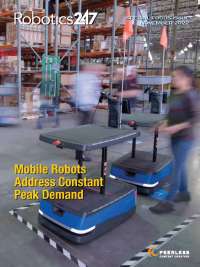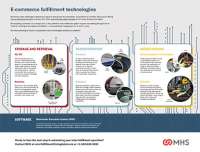We both know people who have trouble distinguishing between their wants and needs. You’ve probably got someone in mind already. We do live in a society with options we never realized were possible just a short time ago. Remember, only Steve Jobs knew each of us needed a smart phone before 2007. Kind of makes you smile, doesn’t it?
That said, the distinguishing line between wants and needs is starting to blur in the warehouse and distribution center, too. That shift is actually a convergence of several forces.
Labor Shortages
Yes, the consumer is demanding more of these facilities. And that force is no less powerful if it is coming from a retail location or an individual. Meanwhile, labor is scarce and DC managers are looking in new places to find relief.
Automation would be nice, but can be costly. There’s also the matter of flexibility of processes on the floor. Centralized, fixed-location equipment that restricts process flow is nobody’s friend these days.
It wasn’t so long ago that much of that composite reality didn’t exist. Instead, DC managers simply wanted equipment to reduce labor and make processes more flexible without excessive cost.
Robotic Palletizing System
That’s the story behind the story of a new palletizing robotic system from MHS, explains director of product management Bruce Bleikamp. It’s also the story of a DC manager whose wants have become needs.
First, the basics of the system: Mujin and MHS have come up with a palletizing robot and autonomous mobile robot (AMR) combo. It eliminates long, fixed conveyors that feed individual cases to a single, centralized palletizing station. Instead, shorter conveyor feeds cases to robots located close to the production lines. Throughput is up to 120 cases an hour with expected 99.95% accuracy.
Bleikamp explains:
“This is a great opportunity to automate a process while maximizing flexibility and taking people out of the equation so they can be redeployed to tasks that make better use of their skills.”
As Bleikamp also points out, this is a smart system. Not only does it include the infeed conveyor and AMRs, but something called MHS Helix. That’s a modular warehouse execution system (WES) that integrates the system with a warehouse management system (WMS) as well as an enterprise resource planning (ERP) system.
Mujin supplies the palletizer’s robot end-of-arm tooling, robotic controls and robotic system integration. MHS provides the AMRs, safety systems, and overall system control including case tracking from inbound case to outbound pallet.
The entire system was inspired by the company that installed it late last year. Bleikamp explains the company wanted to change its fixed palletizing system. It was open to new technology and wanted to go beyond a traditional centralized palletizing area and stretch wrapping approach.
Efficient Palletizing
The system eliminates the danger of a single palletizer or conveyor going down and bottlenecking the entire shipping operation. By decentralizing the palletizing operation, one failure has a much smaller impact on operations.
Significant amounts of pallet conveyors and transfers were also eliminated, saving overall equipment costs and leaving the area more accessible to maintenance and operating personnel. As many as four decentralized palletizer locations may be installed.
Kind of sounds like the established wants/needs story has been turned on its head in at least one DC.
Related Resource
How to Navigate a Maturing Warehouse Robotics Market
By making a plan and taking a step-by-step approach to introducing automation, operations can create facilities with exceptional labor efficiency, order accuracy and more - whether technically a fully automated warehouse or not. Download Now!
About the Author
Follow Robotics 24/7 on Linkedin
About the Author
Follow Robotics 24/7 on Linkedin
About the Author
Follow Robotics 24/7 on Linkedin
Article topics
Email Sign Up






















